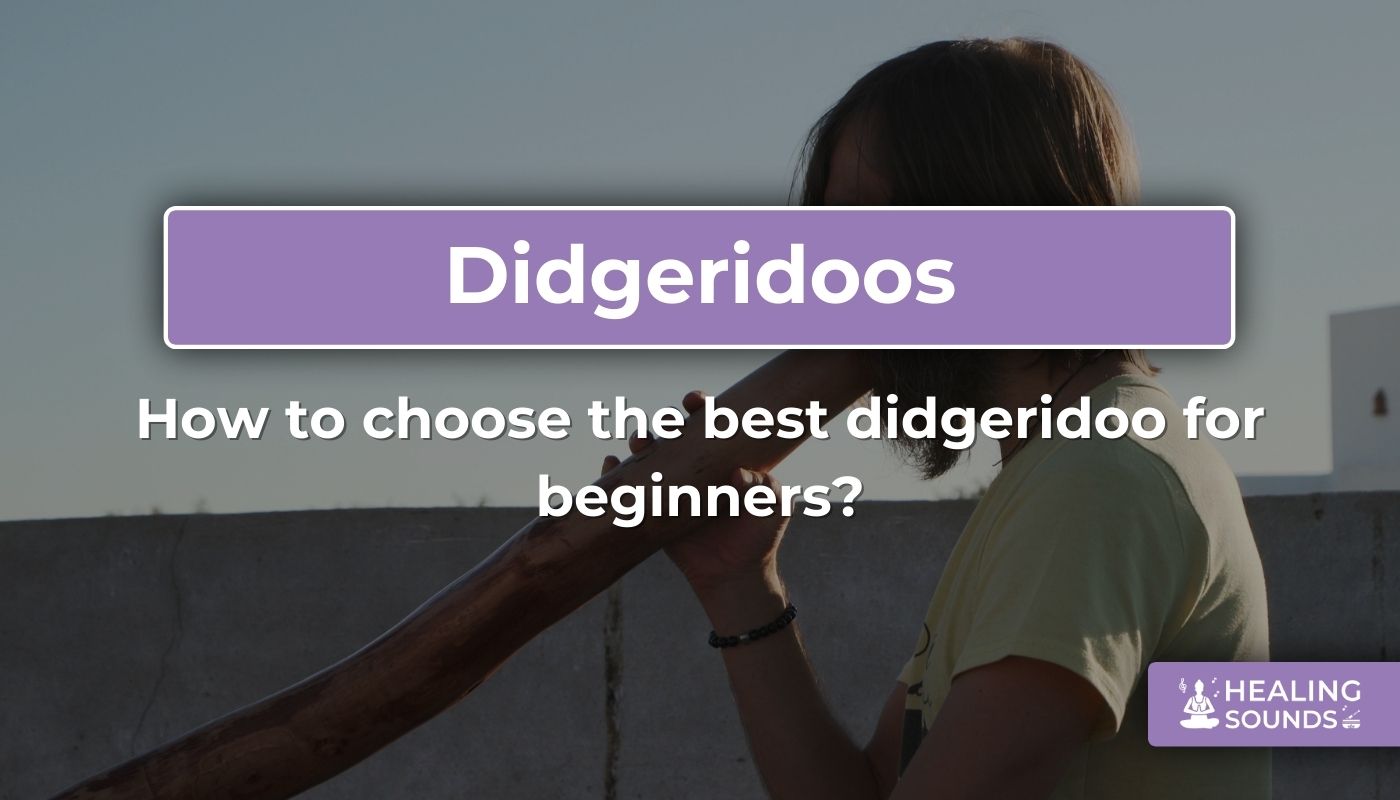Das Didgeridoo-Spielen ist ein aufregender Schritt in eine Welt voll resonanter Klänge, alter Kultur und tiefer Entspannung. Wenn Sie sein einzigartiger Klang und sein Potenzial für Klangheilung anziehen, ist die Suche nach dem besten Didgeridoo für Anfänger der erste wichtige Schritt. Dieses uralte Didgeridoo-Instrument , das von den australischen Ureinwohnern stammt, bietet mehr als nur Musik; es ist ein Werkzeug für Achtsamkeit und Verbundenheit. Doch wie findet man bei der großen Auswahl das richtige Instrument für den Anfang? Dieser Leitfaden hilft Ihnen, die Auswahl zu finden und das perfekte Instrument für den Einstieg zu finden.
Warum ein Didgeridoo wählen? Der Reiz des Klangs
Der tiefe, vibrierende Klang des Didgeridoos ist faszinierend. Er schwingt nicht nur in der Luft, sondern auch im Inneren des Spielers und Zuhörers. Er wird oft in Klangheilungs- und Meditationspraktiken eingesetzt, um Ruhe und Zentriertheit zu fördern. Historisch in Aborigine-Zeremonien verwendet, hat sich seine Anziehungskraft weltweit verbreitet.
Neben seinem einzigartigen Klang bietet das Didgeridoo-Spielen spürbare Vorteile. Es erfordert tiefes, kontrolliertes Atmen, das die Atemfunktion verbessern und Stress abbauen kann. Das Erlernen der Zirkularatmung ist eine meditative Übung, die Konzentration und Präsenz fördert. Wenn Sie dieses Instrument erlernen, verbinden Sie sich mit einem reichen kulturellen Erbe und nutzen ein wirksames Instrument für Ihr persönliches Wohlbefinden.
Was macht ein gutes Didgeridoo für Anfänger aus?
Für Anfänger sollte das ideale Didgeridoo relativ einfach zu spielen, langlebig und mit einem zufriedenstellenden Klang ausgestattet sein, ohne dass fortgeschrittene Techniken erforderlich sind. Wichtige Faktoren sind das Material des Instruments, die Tonart, die Größe und der Tragekomfort des Mundstücks.
Für Anfänger wird häufig ein Didgeridoo in C- oder D-Dur empfohlen. Diese Tonarten bieten oft einen guten Gegendruck (den Widerstand beim Blasen), wodurch es einfacher wird, den Bordunton zu halten und die Zirkularatmung zu erlernen. Schauen wir uns die Materialien an.
Auf das Material kommt es an: Holz vs. Alternativen
Das Material beeinflusst maßgeblich Klang, Gewicht, Haltbarkeit und Preis des Didgeridoos. Traditionelle Didgeridoos werden aus Harthölzern wie Eukalyptus hergestellt, die von Termiten auf natürliche Weise ausgehöhlt werden. Moderne Optionen umfassen andere Hölzer, Bambus und synthetische Materialien wie PVC.
Didgeridoos aus Holz , beispielsweise aus Teakholz oder Eukalyptus, werden für ihren warmen, resonanten und komplexen Klang geschätzt. Sie bieten ein authentisches Erlebnis und eine Verbindung zur Herkunft des Instruments. Obwohl sie möglicherweise schwerer sind und mehr Pflege erfordern, ist die Klangqualität oft unübertroffen.

Didgeridoo, australisches Teakholzinstrument
$149.90 $209.90
Dieses Didgeridoo der Einstiegsklasse ist aus resonantem Teakholz gefertigt und bietet einen vollen Klang, perfekt für Anfänger, die authentischen Klang entdecken möchten.
Entdecken Sie Teak DidgeridooAlternativen wie PVC-Didgeridoos sind leicht, äußerst langlebig und sehr erschwinglich, was sie zu einer praktischen Wahl für Anfänger oder Reisende macht. Bambus-Didgeridoos bieten einen guten Mittelweg, da sie oft leichter als Hartholz sind, aber dennoch einen angenehmen, natürlichen Klang bieten. Berücksichtigen Sie bei der Auswahl Ihr Budget, Ihre Mobilitätsanforderungen und das gewünschte Klangprofil.
Den richtigen Schlüssel und die richtige Größe finden
Länge und Durchmesser (Bohrung) des Didgeridoos bestimmen seine Tonhöhe (Tonart) und Klangqualität. Längere Instrumente erzeugen im Allgemeinen tiefere Töne, während kürzere höhere Töne erzeugen. Eine weitere Bohrung erzeugt einen tieferen, resonanteren Klang mit weniger Gegendruck, während eine engere Bohrung mehr Gegendruck bietet, was manche beim Erlernen der Zirkularatmung hilfreich finden.
Wie bereits erwähnt, werden für Anfänger häufig Tonarten wie C, D oder E empfohlen. Ein Instrument mit einer Länge von etwa 1,2 Metern ist ein gängiger Ausgangspunkt, da es eine handliche Größe und einen ausgewogenen Klang bietet. Probieren Sie nach Möglichkeit verschiedene Größen und Tonarten aus, um herauszufinden, was sich für Sie richtig anfühlt.
Worauf Sie beim Kauf Ihres ersten Didgeridoos achten sollten
Wenn Sie bereit sind, ein Didgeridoo zu kaufen , achten Sie auf einige wichtige Merkmale. Achten Sie auf eine glatte Innenbohrung, da Rauheit den Klang negativ beeinflussen kann. Das Mundstück sollte bequem sein – Bienenwachs wird oft verwendet, um eine individuelle, bequeme Abdichtung zu schaffen.
Berücksichtigen Sie den Gegendruck – fällt es Ihnen zu schwer oder zu leicht, den Bordunton zu erzeugen? Ein moderater Druck ist zum Lernen meist am besten. Vertrauen Sie schließlich Ihren Ohren. Fühlt sich der Klang angenehm an? Wählen Sie ein Instrument, dessen Klang Ihnen gefällt.
Entdecken Sie unsere anfängerfreundlichen Didgeridoos

179,90 €
249,90 €
Dieses aus Bambus gefertigte Didgeridoo erzeugt satte Töne, die sich ideal zum Meditieren und zum Finden des eigenen Rhythmus als Anfänger eignen. Mehr erfahren ➔

159,90 €
219,90 €
Erleben Sie die traditionelle Resonanz von Eukalyptusholz. Bietet tiefe, beruhigende Töne, geeignet für Anfänger, die sich auf Klangheilung konzentrieren. Mehr erfahren ➔

149,90 €
209,90 €
Kompakt und leicht zu transportieren, ist dieses Spiral-Didgeridoo ideal für Anfänger, die überall üben möchten. Mehr erfahren ➔
Budget und Bezugsquellen
Didgeridoos für Anfänger sind in verschiedenen Preisklassen erhältlich. PVC-Modelle sind oft am günstigsten, während hochwertige Hartholzinstrumente eine höhere Investition darstellen. Legen Sie ein Budget fest, das Ihrem Engagement entspricht. Seriöse Anbieter wie Healing Sounds bieten eine kuratierte Auswahl hochwertiger Instrumente für Anfänger, mit detaillierten Beschreibungen und Fokus auf die heilenden Aspekte des Klangs.
Erste Schritte: Grundlegende Spieltipps
Sobald Sie Ihr Didgeridoo haben, beginnt die Reise erst richtig! Der Grundklang, auch Dröhnen genannt, entsteht durch lockeres Vibrieren der Lippen, ähnlich wie bei einem „Himbeer“-Geräusch, während Sie sanft in das Instrument blasen. Achten Sie auf einen gleichmäßigen, entspannten Luftstrom.
- Beginnen Sie mit kurzen, regelmäßigen Übungseinheiten (10–15 Minuten).
- Konzentrieren Sie sich zunächst darauf, ein klares, gleichmäßiges Dröhnen zu erreichen.
- Seien Sie geduldig mit der Zirkularatmung – sie braucht Zeit! Sehen Sie sich Tutorials an und teilen Sie die Übung in kleine Schritte auf.
- Experimentieren Sie beim Summen mit Vokalen (wie „eee“, „ooo“, „aaa“), um verschiedene Obertöne zu entdecken.
- Üben Sie Achtsamkeit: Achten Sie auf die Schwingungen und Ihren Atem.
Das Erlernen der Zirkularatmung – Einatmen durch die Nase und gleichzeitiger Luftstrom aus dem Mund mithilfe der gespeicherten Wangenluft – ist der Schlüssel zum kontinuierlichen Spielen. Obwohl es anfangs eine Herausforderung ist, gelingt es den meisten Anfängern mit regelmäßigem Üben innerhalb weniger Wochen oder Monate.
Kulturelle Sensibilität: Respektvoll spielen
Das Didgeridoo hat für viele australische Aborigines eine tiefe kulturelle Bedeutung. Obwohl es sich weltweit verbreitet hat, ist es wichtig, es mit Respekt zu erlernen. Traditionell wurde das Didgeridoo in bestimmten kulturellen Kontexten von Männern zu zeremoniellen Zwecken gespielt. Seine Verwendung variiert jedoch stark zwischen den verschiedenen Aborigine-Nationen, und heute wird es weltweit von Menschen aller Herkunft gespielt.
Gehen Sie respektvoll mit dem Instrument um, achten Sie auf seine Ursprünge und lernen Sie mehr über die vielfältigen Kulturen der australischen Aborigines. Ressourcen wie das Australian Institute of Aboriginal and Torres Strait Islander Studies (AIATSIS) bieten wertvolle Einblicke.
Fazit: Ihre Didgeridoo-Reise beginnt
Bei der Auswahl des besten Didgeridoos für Anfänger müssen Faktoren wie Material, Tonart, Größe, Budget und persönliche Resonanz berücksichtigt werden. Ob Sie sich für ein traditionelles Holzdidgeridoo mit seinem authentischen Klang oder ein praktisches Modell aus PVC oder Bambus entscheiden, das richtige Instrument unterstützt Ihren Lernprozess und stärkt Ihre Verbindung zu seinem einzigartigen Klang.
Konzentrieren Sie sich auf leichtes Spielgefühl, ein angenehmes Spielgefühl und einen inspirierenden Klang. Lernen ist eine Reise, die nicht nur Techniken wie die Zirkularatmung umfasst, sondern auch das meditative und heilende Potenzial dieses unglaublichen Didgeridoos . Healing Sounds unterstützt Sie auf Ihrem Weg mit hochwertigen Instrumenten, die für Entdeckungen und Wohlbefinden entwickelt wurden.
Häufig gestellte Fragen zur Auswahl eines Didgeridoos
Achten Sie auf ein bequemes Mundstück (Bienenwachs ist üblich), eine glatte Innenbohrung für einen klaren Klang, einen angemessenen Gegendruck (nicht zu stark, nicht zu leicht zu blasen), eine Tonart/Tonhöhe, die Ihnen gefällt (C, D, E sind gute Ausgangspunkte) und ein langlebiges Material, das Ihren Anforderungen entspricht (Holz, Bambus, PVC).
Für Anfänger werden oft die Tonarten C, D oder E empfohlen. Diese Tonhöhen bieten in der Regel eine gute Balance zwischen Spielbarkeit und Klangtiefe und erleichtern so das Erlernen des Grundtons und von Techniken wie der Zirkularatmung .
In einigen kulturellen Traditionen der Aborigines wurde das Didgeridoo bei Zeremonien hauptsächlich von Männern gespielt, Frauen war das Spielen untersagt. Diese Praxis variiert jedoch stark zwischen den verschiedenen Aborigine-Nationen, und weltweit wird das Instrument heute von Menschen jeden Geschlechts gespielt. Es ist wichtig, das Spielen mit kulturellem Respekt und Bewusstsein anzugehen.
Beginnen Sie mit dem Erlernen des Grundtons: Entspannen Sie Ihre Lippen und blasen Sie sanft, um sie zum Vibrieren zu bringen (wie eine Himbeere). Halten Sie den Atemdruck konstant. Sobald Sie einen Grundton halten können, üben Sie Techniken wie das Ändern von Vokalen und arbeiten Sie schließlich daran, die Zirkularatmung für kontinuierliches Spielen zu erlernen.
Ein gutes Didgeridoo für Anfänger ist in der Regel leicht zu spielen (oft in den Tonarten C, D oder E), langlebig, erschwinglich und hat einen moderaten Gegendruck. Materialien wie hochwertiger Bambus, Teakholz oder auch hochwertiges PVC können geeignet sein. Der Tragekomfort des Mundstücks und die allgemeine Handlichkeit in Bezug auf Größe und Gewicht sind ebenfalls wichtige Faktoren.

